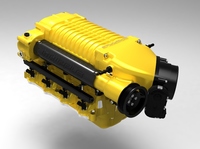Supercharging vs. Turbocharging

Forced induction can get some serious power out of your Mustang’s engine, but there are two ways to get more air into the combustion chambers: supercharging and turbocharging. What should you consider when choosing these power adders for your build?
How Forced Induction Works
Naturally aspirated engines use the pressure difference between the inside of the cylinder and the outside to draw in air, while superchargers and turbochargers pump air into the cylinders. More air means more fuel can be burned, and more power can be made.
A supercharger’s impeller or rotors are driven by a belt connected to the crankshaft. It takes power to run a supercharger, but the additional engine output easily makes up for it.
A turbocharger uses two impellers connected by a shaft: as gases pass by the exhaust impeller, it spins the intake impeller. Although not “free” energy, by harnessing otherwise wasted energy from the exhaust, the losses are significantly lower than a supercharger.
Superchargers vs. Turbochargers: Power, Installation and Tunability
Positive displacement, or, roots type supercharger installation is straightforward: replace the intake manifold with the supercharger, connect the intercooler and intake, and add the pulleys needed for the drive system. Turbochargers need to be hooked up to the exhaust, have an oil line run to them to lubricate the shaft bearing, and have intake piping added to connect them to the intercooler, intake and filter. Centrifugal superchargers, with some exceptions, also require additional oil lines and air plumbing.
A supercharger increases speed with the engine, providing a steady increase in power across the RPM range. A turbocharger can take a while to spool up until it’s moving fast enough to deliver more power, causing delayed throttle response.
A supercharger’s boost pressure can be altered by changing the size of the drive pulley. A boost controller can change how the turbocharger’s wastegate reacts to pressure, allowing, and somtimes requiring, modification and multiple boost profiles to fit different scenarios including street and track driving. This boost can also be increased to compensate for lower outside air pressure at high altitudes, although increased heat and backpressure means there will still be some power loss.
Cooling the Intake Charge
Gases heat up when they’re compressed, which means the air coming straight out of the impeller can be hot enough to cause problems with detonation. There are two ways to deal with this heat:
An intercooler is simply a radiator: air-to-air coolers pass the intake charge through the core directly, while water-to-air systems run coolant through the radiator and then around the intake. Choosing between these two methods is usually a matter of space: since Mustangs have plenty of room for the intercooler and intake piping, so air-to-air systems are pretty common, although Vortech, VMP, Roush, and Ford Performance use water-to-air for a cleaner installation.
Methanol injection systems such as our Mr. Freeze, adds a methanol/water mixture to the intake, using this fluid to absorb heat and drop both intake and combustion chamber temperatures. This works great on high boost applications, allowing for more timing advance and the use of lower octane fuels.
Supporting Modifications
To get the most out of forced induction, every part of the engine needs to be taken into account so it can keep up with the added power. This starts with the fuel system, which needs to be retuned and upgraded to deliver more fuel to match the increase in incoming air. At minimum, that means adding larger injectors and a tuning control system to increase injector output. Very often additional, or larger, fuel pumps are also needed to supply the volume of fuel required by the larger injectors.
Even minor intake restrictions can make it harder for the impeller to draw in air, which can really cut into power. Switching to a larger throttle body and high flow maf and air filter can reduce this resistance. Anderson Power Pipe® intake systems are also a proven way to increase horspower output in these types of applications by getting more air into the supercharger. Likewise, exhaust flow also gets higher with the added air, and the turbo’s exhaust impeller increases flow resistance, requiring a less restrictive exhaust to get the most power.
The ignition system needs to be able to handle added combustion chamber temperatures, both in its ability to increase spark energy, adjust timing and its resistance to heat. That means using an ignition controller that can delivery more spark energy, retard the spark more than a stock unit and colder spark plugs that won’t get hot enough to cause pre-ignition.
More power means more heat, which means better cooling is needed for high output applications. Using a higher flow water pump and a high-performance radiator can help keep the engine cool.
Sound Complicated? Anderson Ford Motorsport Makes Forced Induction Easy
We know Ford Mustang performance parts because we’ve been turning these cars for decades. Our power packages have everything you need to add a turbocharger or supercharger including ignition, intake, exhaust and electronic components so you can have your engine working in no time. Have a Cobra or Ecoboost Mustang that came with forced induction from the factory? We have the parts you need to get the most out of these engines.
Recent Posts
-
Bringing the Fox Body Mustang into the 21st Century with Holley Terminator X
Anderson Ford Motorsport has been in the Fox Mustang performance industry since 1989. One of the bi …22nd Oct 2021 -
Roush Supercharger install on a 2019 Ford Mustang
Check out this 2019 Ford Mustang before and after we installed a Roush Supercharger. …21st Feb 2020 -
All Blower Installations are not Equal.
Why Should You Choose a Company to Install Your Blower That Has a Dyno Facility In-House?Are all de …24th Jan 2020


